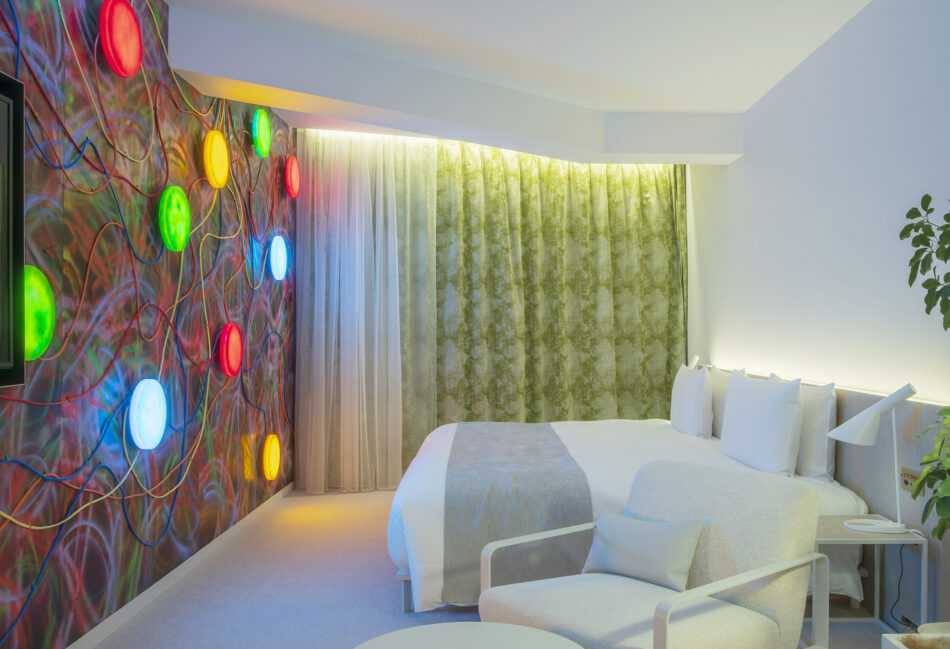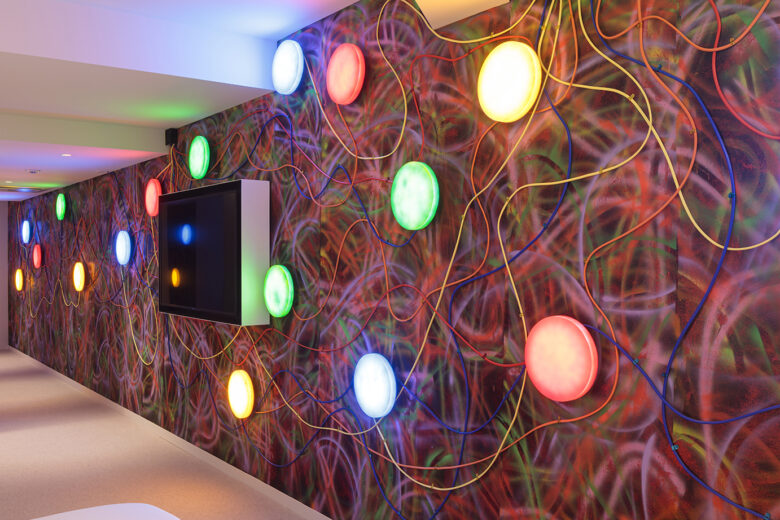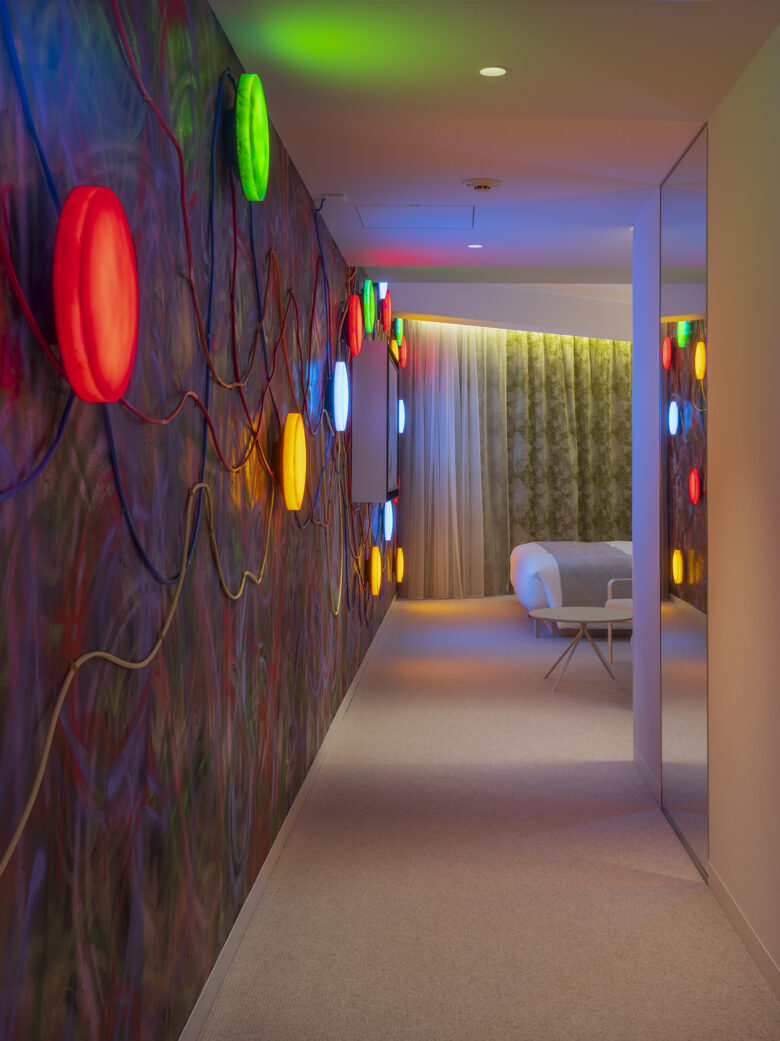ROOM 19 鬼頭 健吾 / KENGO KITO


interstellar

1977年、愛知県名古屋市生まれ。2001年、名古屋芸術大学美術学部絵画学科洋画コース卒業。2003年京都市立芸術大学大学院美術研究科絵画専攻修了。2008年、五島記念文化財団の助成を受けニューヨークに滞在。2010年、文化庁新進芸術家海外研修員として渡独。2015年より高崎市を拠点に活動。京都芸術大学大学院教授。主な個展に、「Full Lightness」(2020年、京都市京セラ美術館、京都)、「MULTIPLE STAR I-III」(2017年、ハラミュージアムアーク、群馬)、「Migration 回遊」(2015年、群馬県立近代美術館、群馬)など。主なグループ展に、「絵画のミカタ」(2020年、群馬県立近代美術館)、「アイチアートクロニクル展」(2019年、愛知県美術館、愛知)、「六本木クロッシング2007未来への脈動」(2007年、森美術館、東京)など多数。2008年、五島記念文化賞美術新人賞受賞。作品は国立国際美術館(大阪)、豊田市美術館(愛知)などにコレクションされている。
鬼頭は、2000年代初頭より頭角を現し、フラフープ、パラソル、布や電飾など、日常的な素材を用いたカラフルな大型インスタレーションで知られている。鬼頭の作品において、用いられるそれらの素材は、それぞれの用途や意味がはぎ取られ、素材や色の単位に落とし込まれる。無限に増殖していくように繰り返されることで、世界を構成する一要素としての細胞、または宇宙のような広がりを持つ。近年は、平面作品も多く制作し、「絵画」への強いまなざしが感じられる。かつて、抽象表現主義の画家たちが巨大なキャンバスに中心を持たないオールオーバーな画面を描くことで、イメージの再現を回避し、鑑賞者を純化された「絵画空間」の世界に引きずり込んだ。鬼頭の絵画もまた、人工的に作られたラメや照明といった工業製品をそのまま使い、物語や意味を徹底的に排することで、物質に満ちた現代の世界そのものを絵画の世界に圧縮するようである。本作《Interstellar》は、部屋の空間に合わせて新たに制作された。日常とは異なるつかの間の時を過ごす「部屋」は、まさに「星と星の間(インターステラー)」の状態と言える。私たち自身も常に揺れ動く存在であり、世界を構成するひとつの存在である事に気づかせる。
Kengo Kito was born in Nagoya, Aichi Prefecture, in 1977. He graduated from the Oil Painting Course at Nagoya University of the Arts in 2001, and obtained his MA from the Department of Painting at Kyoto City University of Arts in 2003. In 2008, he received a grant from the Gotoh Memorial Foundation for an extended stay in New York. From 2010 to 2012, he lived in Germany under the Japanese Agency of Cultural Affairs’ Program of Overseas Study for Upcoming Artists. Based in Takasaki since 2015, he is a professor at the Graduate School of Kyoto University of the Arts. His major solo exhibitions include Full Lightness (Kyoto City KYOCERA Museum of Art, 2020),MULTIPLE STAR I-III (Hara Museum ARC, Gunma, 2017),and Migration (Museum of Modern Art, Gunma, 2015). His major group exhibitions include How to observe paintings (Museum of Modern Art, Gunma, 2020),Grand Reopening Exhibition: Aichi Art Chronicle 1919-2019 (Aichi Prefectural Museum of Art, 2019),and Roppongi Crossing 2007: Future beats in Japanese Contemporary Art (Mori Art Museum, Tokyo, 2007).
He received the Newcomer of the Year Award at the 2008 Gotoh Memorial Culture Awards, and his works are in the collections of institutions including the National Museum of Art, Osaka, and the Toyota Municipal Museum of Art.
Kito began to distinguish himself in the early 2000s and is known for his colourful, large-scale installations made from everyday materials like hula hoops, parasols, textiles and decorative lighting. In his works, these materials are stripped of their intended use and meaning and reduced to units of colour and exture. Through repetition evoking the endless reproduction of cells as elements making up the world, his works take on a cosmic expansiveness. His recent emphasis on two-dimensional pieces, suggesting a strong interest in “painting” as such. In the past, Abstract Expressionist artists would employ a decentred, “allover” approach to cover canvases and guide the viewer into a purified pictorial space where imagistic recreation was avoided. In Kito’s works, too, the use of industrial materials like artificial glitter and decorative lighting in unaltered form removes all story or meaning, as if compressing our modern, material-filled world into the realm of painting. This work, Interstellar, was created to match the atmosphere of the room. Spending time in a room outside the everyday can be described as being between the stars, the literal meaning of “interstellar”. The work urges the viewer to recognize that we ourselves are inconstant, wavering presences amid the things that make up our world.

